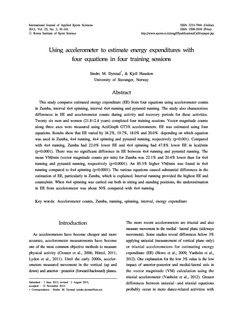Using accelerometer to estimate energy expenditures with four equations in four training sessions
Journal article, Peer reviewed
Permanent lenke
http://hdl.handle.net/11250/223076Utgivelsesdato
2013Metadata
Vis full innførselSamlinger
Originalversjon
Dyrstad, S.M.; Hausken. K. (2013) Using accelerometer to estimate energy expenditures with four equations in four training sessions. International Journal of Applied Sports Sciences, 25(2), pp. 91-101Sammendrag
This study compares estimated energy expenditure (EE) from four equations using accelerometer counts
in Zumba, interval 4x4 spinning, interval 4x4 running and pyramid running. The study also characterizes
differences in EE and accelerometer counts during activity and recovery periods for these activities.
Twenty six men and women (21.8±2.4 years) completed four training sessions. Vector magnitude counts
along three axes were measured using ActiGraph GT3X accelerometers. EE was estimated using four
equations. Results show that EE varied by 34.2%, 19.7%, 18.0% and 20.0% depending on which equation
was used in Zumba, 4x4 running, 4x4 spinning and pyramid running, respectively (p<0.001). Compared
with 4x4 running, Zumba had 22.0% lower EE and 4x4 spinning had 47.8% lower EE in kcal/min
(p<0.0001). There was no significant difference in EE between 4x4 running and pyramid running. The
mean VM/min (vector magnitude counts per min) for Zumba was 22.1% and 20.4% lower than for 4x4
running and pyramid running, respectively (p<0.0001). An 85.3% higher VM/min was found in 4x4
running compared to 4x4 spinning (p<0.0001). The various equations caused substantial differences in the
estimation of EE, particularly in Zumba, which is explained. Interval running provided the highest EE and
counts/min. When 4x4 spinning was carried out both in sitting and standing positions, the underestimation
in EE from accelerometer was about 50% compared with 4x4 running.
